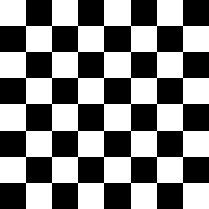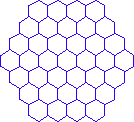Introduction to Symmetry
Ever notice, that some things are symmetric?
For example, the letters H, A, M, all look the same left and right. The letters B, C, D are the same along a horizontal line. The letter X is symmetric both horizontally and vertically. A perfectly round O is symmetric around its center.
These are simple examples of symmetry. If you look at staircase or brick walls, you'll notice that a pattern repeats again and again. These are other examples of symmetry.
Now, in many floor tilings, wallpaper, or decorative patterns on vases, you'll see a pattern that repeats itself. These are all symmetries.
Mathematicians have studied and analyzed symmetries, and have classified them into types.
Let's look at some of the basic symmetries.
Types of Symmetry
Rotational Symmetry
Here are some examples of rotational symmetry:
The yin-yang symbol ☯ has a 180° rotational symmetry. Other examples of 180° rotational symmetries includes the idealized letter shapes of N O X Z.The equal-sided triangle, or the radio active symbol ☢, or the bio-hazard symbol ☣, all have 3-fold (120°) rotational symmetry.
The swastika sign 卍 has a 4-fold (90°) rotational symmetry.
The penta-star ★ has a 5-fold rotational symmetry. (72°)
The star of david ✡ has 6-fold rotational symmetry. (60°)
Reflectional Symmetry
The heart icon ♥, and other playing-card symbols the spade ♠, the club ♣ each all have a reflectional symmetry. The diamond ♦ has 2 reflectional symmetries (one vertical and one horizontal). The capital letters BCDEKOX have reflectional symmetry (along a horizontal line), and letters AHIMOTUVWXY have reflectional symmetries too (along a vertical line). Humans, also have a reflectional symmetry, as well as all animals. (this is because there is no evolutionary advantage to favor a particular side.)
Translational Symmetry
A translational symmetry is just the same pattern moved into a different location. For example, rail-road track, staircase, ladder, all have translational symmetry in one direction. (forward and backward here are counted as the same direction.) A brick wall, a tiled floor, chess-board, a honeycomb, all have translational symmetries in more than one directions.
Glide-Reflection Symmetry
A glide-reflection symmetry is a combination of reflection symmetry and translation symmetry. The most obvious example of glide-reflectional symmetry is foot prints. The right foot prints, are mirrored and moved, to match the left foot prints. Glide-reflection symmetry are commonly found on the decorative patterns on vases or the edges of carpets.
Symmetries In Planar Patterns
In a planar pattern (such as tilings, wallpapers, mosaics, Persian carpets), often there are many combinations of different symmetries in it.
This topic is slightly complex, but let's take a look at a simple example — the checker-board.

Suppose we have a checker-board, made up of alternating black and white squares. (suppose the board is infinitely large so that the squares extends all ways on all sides)
There are several symmetries present. For example, there are translational symmetries, because if you move the pattern up 2 squares or to the right 2 squares, the whole thing becomes itself again.
There are also rotational symmetries. For example, if you rotate the chess board around any of the square's center by 90°, the pattern coincides again. It's a 4-fold rotational symmetry. (4-fold because there are 4 of them, that is, four 90° rotational symmetry) The corners where any 4 squares meet, are also the centers of 2-fold rotational symmetries, each one being 180° rotational symmetry.
There are also reflectional symmetry. Along any horizontal or vertical lines that cut thru any square's center, are also reflectional symmetry lines.
Surprisingly, there are also glide-reflection symmetries. The line of any two neighboring squares is a glide-reflection line.
(a easy way to see symmetries is to put a translucent sheet of the pattern on top of the pattern, and move the translucent sheet about)
The above is a analysis of the symmetries on a checker-board pattern. Try to do the same analysis on a honeycomb pattern. (a tiling of regular hexagons)

As you can see, a checker-board pattern has many types of symmetries. Each symmetry has a particular point or line associated with it. For example, a rotational symmetry has a center at a particular position. A translational symmetry has a direction and length. A reflection symmetry has a line. A glide-reflection symmetry also has a line. And, all these points and or lines, are positioned on the plane in some specific, regular way, relative to each other. These positions and symmetries, make up the combination of symmetries that represent this pattern's symmetry set, is called a “wallpaper-group” by mathematicians. Different planar patterns, will have different symmetry combinations.
It turns out, these combinations of symmetries (or wallpaper-groups), are of only limited types. In fact, there can only a total of 17 possible types of combination.
For a mathematical treatment, see: The Discontinuous Groups of Rotation and Translation in the Plane .
See also: